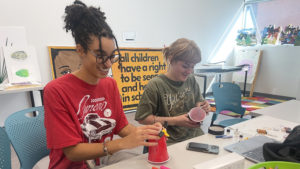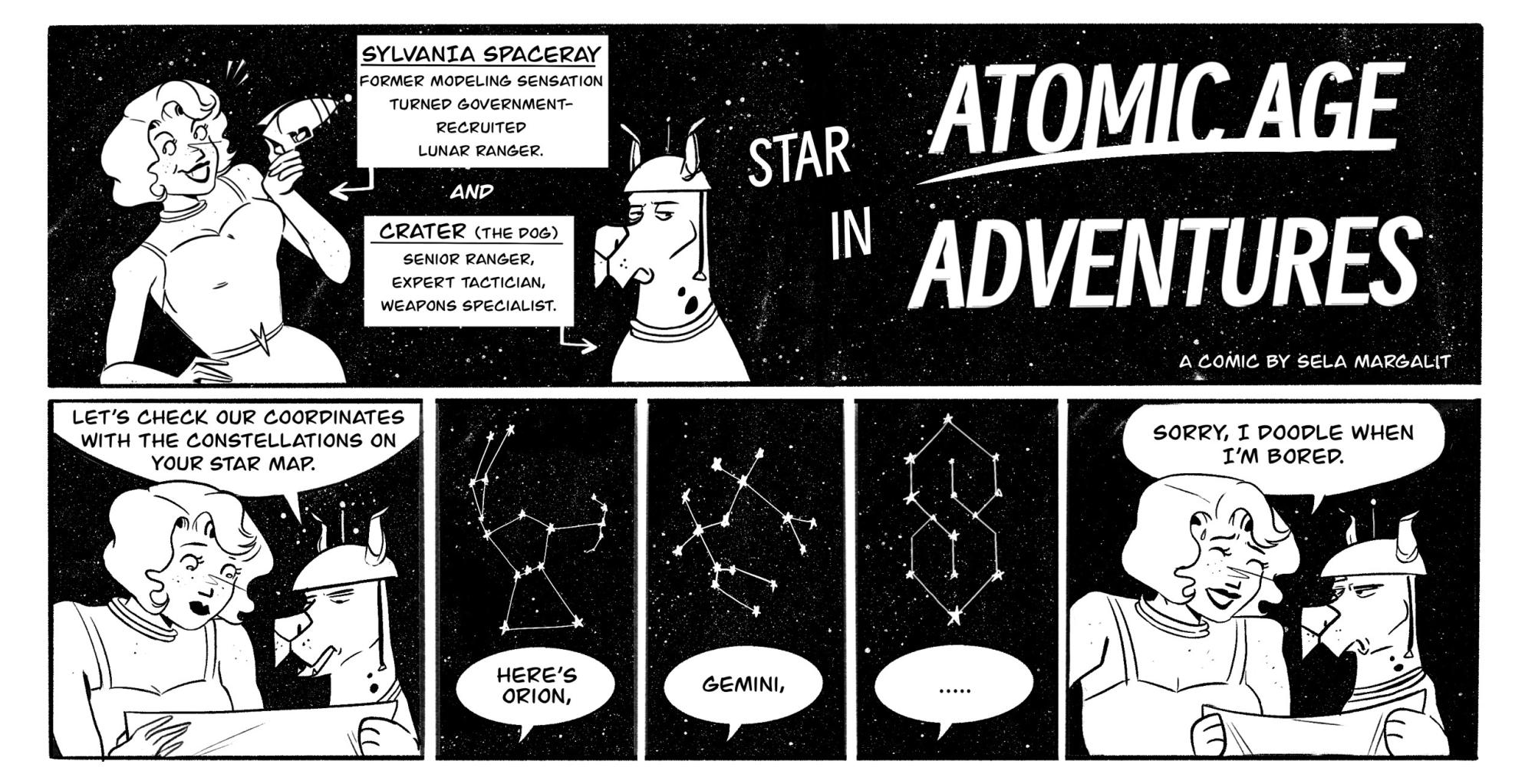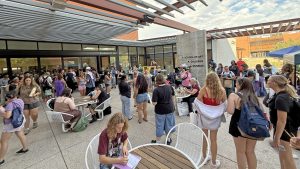
Students explore STEAM practices in ‘ArtMachines’ workshop
December 4, 2024Under the guidance of Assistant Professor Ilayda Altuntas Nott, Art and Visual Culture Education students immersed themselves in a computational art-making, sensory-based learning experience — emphasizing the arts in STEAM (Science, Technology, Engineering, Arts and Mathematics) practices.
The fall 2024 workshop, “ArtMachines: Drawing, Feeling, and Resounding,” invited the AVCE students to explore the intersections of creativity, digital and material experimentation in ARE 431/531.
Collaborative Inquiry: The Artistic Exploration of Ziyu Feng and Lei Wang
Students Ziyu Feng and Lei Wang demonstrated the power of collaboration and experimentation in their drawing machine project. Starting with a vision to create randomness in their artwork, the duo tackled challenges like motor assembly and design stability. Through trial and error, they incorporated small motors, cups, and switches to bring their machines to life, producing abstract patterns that celebrated the unpredictable.
Their innovative use of materials, including Chinese ink and acrylic paint, highlighted the creative potential of STEAM practices in art education. By layering colors and utilizing the mechanical movements of their machines, Ziyu and Lei showcased how art and technology can merge to create dynamic and thought-provoking results. Their iterative tinkering process emphasizes the value of hands-on experimentation in fostering creativity and problem-solving, reinforcing that exploration is a critical part of learning (Justice, 2016 & Resnick, 2017).
Kasey Hilton: Art, Experimentation, and Familial Collaboration
For Kasey Hilton, the workshop became an interdisciplinary exploration that extended beyond the confines of the classroom. With household items like plastic cups, duct tape, and markers, Kasey constructed multiple drawing robots, even involving her kindergartener and spouse in the creative process. Her robots, equipped with motors and weights, operated across expansive sheets of paper, resulting in distinct and vibrant patterns.
Kasey’s methodical yet creative approach to tinkering embodied the essence of STEAM, integrating problem-solving with artistic inquiry. The interactive motion of her robots, akin to a “dance party,” exemplified how STEAM initiatives can cultivate creativity and foster meaningful connections between artistic practice and everyday life. Activities like these encourage learners to iterate, explore, and develop a deeper understanding of concepts through active engagement (Justice, 2016; Resnick, 2017).
Kiara Imblum: The Pedagogy of Tinkering and Experimentation
Kiara Imblum’s mark-making machine demonstrated a comprehensive engagement with the pedagogical process of experimentation. Initiating with a conceptual framework centered on motion-based art, Kiara developed a drawing robot that underwent numerous iterative design modifications. From extending fan blades to stabilizing markers with rubber bands, her iterative process underscored the pedagogical significance of persistence and complex problem-solving.
Kiara’s reflections highlighted the classroom as a dynamic space of collaborative inquiry, where students engaged in the exchange of ideas and collective learning. Her experience illustrated how engaging with STEAM concepts through tinkering fosters critical thinking and promotes innovative pedagogical approaches in art education. This aligns with Justice and Resnick’s assertion that tinkering allows for the development of critical thinking skills by encouraging learners to engage deeply with materials and processes (Justice, 2016; Resnick, 2017).
Anne Arvizu’s Exploration of Tinkering in Art Education
Anne Arvizu demonstrated her approach in the workshop, emphasizing the intersection of art, motion, and experimental learning, thereby facilitating participants’ engagement with hands-on pedagogical exploration. Anne’s process began with an inquiry-based mindset, fully engaging in the concept of “tinkering”—an iterative cycle of experimentation and analysis. Reflecting on her journey, she articulated her iterative approach, describing how she ‘engaged in exploratory practices and systematically documented observations,’ subsequently revising her methods when initial attempts did not yield optimal outcomes. This iterative approach underscored her capacity for adaptation and innovation, which are essential traits in both art education and broader educational practices. Her experimentation with motors and markers functioned as a practical framework for problem-solving and applied critical thinking. Starting with multiple motors and markers, Anne quickly realized the setup was too heavy, prompting adjustments. Through experimentation, she discovered that a single motor and carefully balanced marker placement allowed the machine to create captivating circular patterns. Each adjustment, from reducing weight to perfecting marker contact with the paper, demonstrated her academic resourcefulness and persistence.
Ultimately, Anne’s ArtMachine achieved a result that exceeded her expectations. “Even though it was not what I originally planned, it was still successful in many ways,” she reflected. This experience underscored the importance of resilience, creativity, and a willingness to learn from every step of the process. Anne’s narrative serves as an exemplary model for students and educators, illustrating the pedagogical power of experimentation in unveiling new dimensions of creative inquiry. Her journey emphasizes that educational success is often rooted not in the flawless execution of a plan, but in the reflective learning that occurs throughout the process.
The Role of STEAM Pedagogy in Fostering Creative Inquiry
Assistant Professor Altuntas Nott integrates these pedagogical approaches into the classroom, addressing a significant gap in contemporary art education. These practices, already explored in other states and institutions, position the arts as a critical nexus for STEAM engagement, computational art-making, and sensory integration. By facilitating students’ experimentation with motors, markers, and innovative materials, art acts as a catalyst for the intersection of creativity and technology. The success of the workshop demonstrates the efficacy of integrating theoretical frameworks with practical application in STEAM-focused art education, inspiring students to engage in critical thinking, effective collaboration, and the exploration of novel creative possibilities. Tinkering functions as an essential pedagogical strategy for enhancing student learning through meaningful, process-oriented exploration (Justice, 2016; Resnick, 2017). This experiential methodology equips future educators with the competencies needed to integrate interdisciplinary practices into their classrooms, while also fostering an appreciation for the value of experimentation and innovation. As demonstrated by the projects of Ziyu, Lei, Kasey, Kiara, and Anne, the confluence of art and technology has the potential to cultivate creative intelligence and drive innovative thought processes.
References
Justice, S. (2016). Learning to teach in the digital age: New materialities and maker paradigms in schools. Peter Lang.
Resnick, M. (2017). Lifelong kindergarten: Cultivating creativity through projects, passion, peers, and play. MIT Press.
















